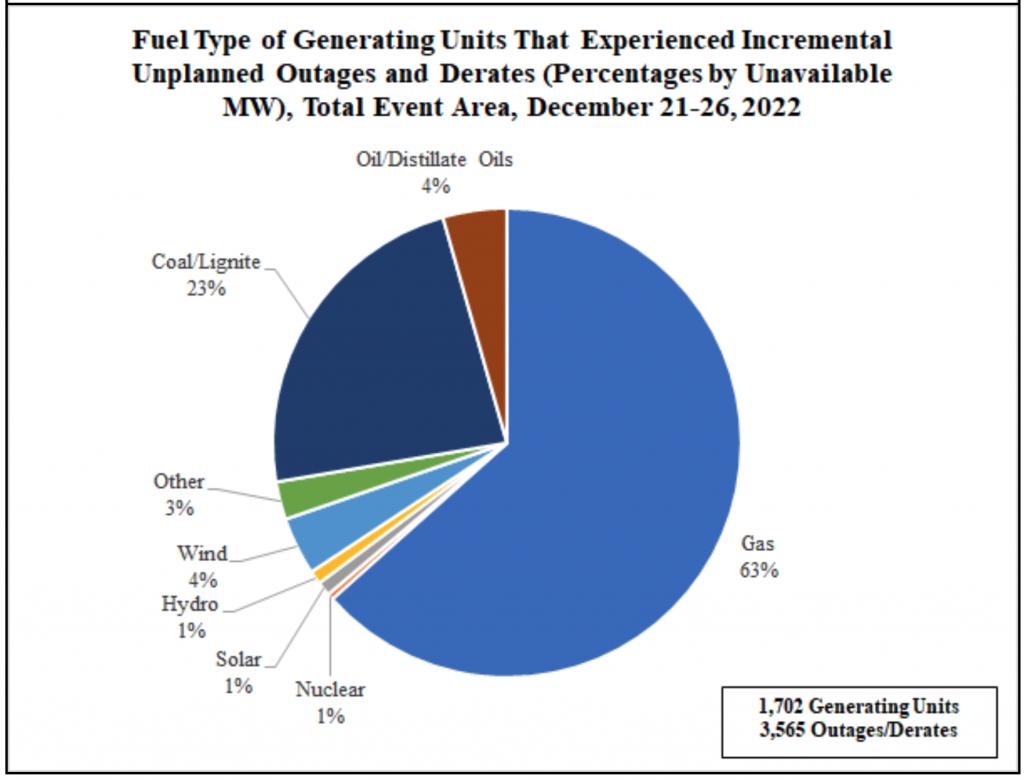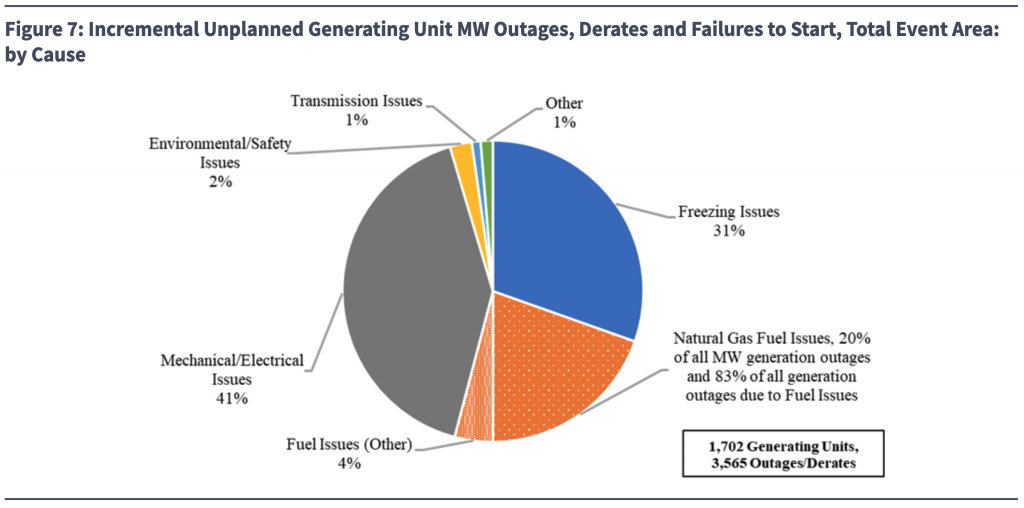Reliance on fossil fuels was last year’s Grinch that stole Christmas — and the real cause of Winter Storm Elliot blackouts

During Winter Storm Elliot last December, 500,000 Duke Energy customers across the Carolinas lost power at one of the coldest times of the year due to rolling blackouts.
Unfortunately, Carolinians weren’t the only ones left in the dark. Thirteen percent of the energy produced in the eastern half of the United States failed during the storm, leaving millions of people without power. Winter Storm Elliot’s outages left people unable to heat their homes and cook holiday meals, and for some communities, power outages can have life or death consequences.
So, what happened and how do we prevent this from happening again?
On Dec. 24, as Winter Storm Elliot bore down on North Carolina, several of Duke’s fossil fuel powered plants were derated, producing less power than expected. Meanwhile, electricity demand was higher than anticipated and Duke was unable to purchase as much power as it needed from other utilities who were also impacted by the storm. This set of circumstances led the company to initiate rotating power outages.There’s a lot to be learned from this horrible confluence of events. Let’s explore five key takeaways from Winter Storm Elliot last December.
1. Failures were caused by fossil fuels, mainly methane gas.
During Winter Storm Elliot, 90% of lost power in the eastern half of the US was from failures in gas, coal or oil burning generation and 63% of lost power was from failed methane gas-powered generation. Meanwhile, just 1% of lost power came from solar and 4% from wind.

Graph from FERC-NERC-Regional Entity Joint Inquiry Into Winter Storm Elliott
2. Winter Storm Elliot was a “déjà vu” moment; we’ve seen it before — reliance on methane gas makes the U.S. electric grid vulnerable.
A top U.S. regulator referred to Winter Storm Elliot as “déjà vu all over again.” Why? Because we’ve already seen the U.S. electrical grid fail time and time again due to poor gas performance in winter weather. At the national scale, Winter Storm Elliot was the fifth event in the past 11 years where grid reliability was jeopardized by cold weather. Gas fuel issues were a common theme among all five events.
“These recurring failures make clear that America’s natural gas infrastructure and electric grid continue to be severely challenged during extreme cold weather events, repeatedly jeopardizing reliability during life-threatening conditions,” said the Federal Energy Regulatory Commission in a recent report.
Methane gas is the most significant fuel source for electricity in the United States, accounting for 40% of electricity generation nationally (and an even larger share in North Carolina). Relying too much on gas for electricity production is risky because gas fuel supply is highly vulnerable during winter storms. During the storm, methane gas production fell by 16% in the lower 48 states, with the most dramatic decreases in the Appalachian region. Production fell while gas demand was high, leading to fuel shortages. Twenty percent of all power loss during Winter Storm Elliot was a direct result of gas fuel issues.

FERC Winter Storm Elliot Report
Cold weather gas shortages are further exacerbated by increased home heating demands. About 60% of U.S. homes use methane gas. Cold winter weather increases the need for home heating at the same time that electricity demand increases and gas production is at risk. As a result, methane gas supply struggles to meet high demand from both home heating and electricity generation during winter storms. The overreliance on gas for both electricity and home heating makes US homes vulnerable to winter outages.
Because electricity production is over-reliant on methane gas and critical elements of the methane gas supply chain (such as electricity-driven compressors) depend on electricity to run smoothly — a failure in one system can lead to a failure in the other, leaving both systems vulnerable. The energy system is disrupted when electricity is unavailable to operate methane gas infrastructure (affecting gas fuel supply) or when methane gas is not available to operate power plants (affecting electricity supply).
3. Wind power helped keep the lights on across the country and could have had a larger role.
During the storm, renewable energy performed well across the country, with wind playing an important role. Strong wind generation prevented blackouts in the Midwest and allowed the Midwest grid operator, MISO, to help neighboring utilities by exporting power. Similarly in Texas, wind and solar generation exceeded expectations during the storm, while Texas’ winterized gas and coal plants performed poorly.
Wind energy could have played an even larger role in preventing blackouts, but limited transmission capacity on the grid prevented the export of power into the regions that needed it most. During the storm, the Midwest had an excess amount of wind energy, which went to waste while the Southeast was experiencing power shortages. If wind energy from the Midwest could have been sent to the Southeast during the storm, blackouts could have been reduced or prevented.
Similarly, more wind production in North Carolina could have produced desperately needed power during the storm. While there were strong wind speeds in North Carolina during the storm, Duke was unable to tap into this potential since the company has not significantly invested in wind turbines — wind accounts for just 0.4% of North Carolina’s energy generation.
Meanwhile, analysis showed that while solar alone would not have eliminated the North Carolina outages (since they occurred in pre-dawn hours), the service interruptions could have been reduced and shortened by solar paired with battery storage.
4. More transmission capacity could have prevented or limited outages.
Interregional transmission, the system by which different parts of the country share power, provides resilience against weather events by allowing energy to be transported from areas that are not affected by a storm to those that are. In addition to preventing blackouts, more interregional transmission could have protected customers from high prices. An additional gigawatt — enough electricity to power 100 Million LED bulbs — of transmission capacity — into Duke territory in the Carolinas could have provided as much as $81 million in benefits by protecting customers from price spikes and outages during the storm.
Participating in an energy market, such as a regional transmission organization, is one strategy to improve resilience by increasing access to cheap and geographically diverse energy sources. A study found that joining an RTO could provide as much as $600 million in benefits to North Carolina customers per year, with $80 million in benefits coming from improved reliability. However, Duke is strongly opposed to joining an energy market, such as an RTO, and has lobbied against bills related to studying energy markets for North Carolina.
5. Since last year, Duke is moving in the wrong direction for reliability.
A year after Winter Storm Elliot, the power grid remains vulnerable to similar events. In fact, North Carolina is at elevated risk of insufficient electricity supply during peak winter conditions this year. Meanwhile, Duke continues to invest in new methane gas infrastructure, falsely claiming that gas is the solution to the very reliability issues it caused during Winter Storm Elliot. Unfortunately, it is unlikely that these new gas plants will improve reliability since they are dependent on the same methane gas fuel system that failed so miserably in Winter Storm Elliot.
A critical year
Next year will be critical for North Carolina’s energy future. The North Carolina Utilities Commission will consider Duke’s proposed Carbon Plan update, which calls for a massive gas buildout of 7.1 gigawatts of new methane gas plants by 2038. Duke is also expected to request approval for two new gas plants in 2024. Despite Duke’s intentions to double down on gas, the future is not yet set. Advocates, like Appalachian Voices, will continue to question the reckless buildout of methane gas infrastructure. It will be a busy year, but we are ready for the fight.
We have the tools to develop a more reliable electricity grid in North Carolina. But, we need to explore new solutions, such as joining a Regional Transmission Organization, that increase the availability of geographically diverse energy sources. Meanwhile, we need increased investment in low-cost resources, like solar and wind, coupled with battery storage. We have far better options than gas. North Carolinians can and should demand better from Duke.
The post Reliance on fossil fuels was last year’s Grinch that stole Christmas — and the real cause of Winter Storm Elliot blackouts appeared first on Appalachian Voices.
Protecting the Central and Southern Appalachian Mountain Region
Source: https://appvoices.org/2023/12/18/winter-storm-elliot/
Anyone can join.
Anyone can contribute.
Anyone can become informed about their world.
"United We Stand" Click Here To Create Your Personal Citizen Journalist Account Today, Be Sure To Invite Your Friends.
Please Help Support BeforeitsNews by trying our Natural Health Products below!
Order by Phone at 888-809-8385 or online at https://mitocopper.com M - F 9am to 5pm EST
Order by Phone at 866-388-7003 or online at https://www.herbanomic.com M - F 9am to 5pm EST
Order by Phone at 866-388-7003 or online at https://www.herbanomics.com M - F 9am to 5pm EST
Humic & Fulvic Trace Minerals Complex - Nature's most important supplement! Vivid Dreams again!
HNEX HydroNano EXtracellular Water - Improve immune system health and reduce inflammation.
Ultimate Clinical Potency Curcumin - Natural pain relief, reduce inflammation and so much more.
MitoCopper - Bioavailable Copper destroys pathogens and gives you more energy. (See Blood Video)
Oxy Powder - Natural Colon Cleanser! Cleans out toxic buildup with oxygen!
Nascent Iodine - Promotes detoxification, mental focus and thyroid health.
Smart Meter Cover - Reduces Smart Meter radiation by 96%! (See Video).








Almost the dumbest thing I’ve read on BIN today. You were beat out by “Indian In The Machine”.